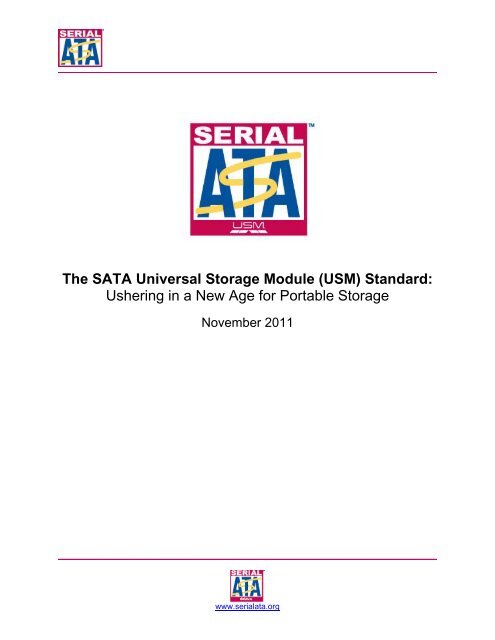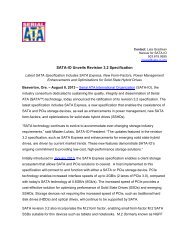The SATA Universal Storage Module (USM) Standard ... - SATA-IO
The SATA Universal Storage Module (USM) Standard ... - SATA-IO
The SATA Universal Storage Module (USM) Standard ... - SATA-IO
Create successful ePaper yourself
Turn your PDF publications into a flip-book with our unique Google optimized e-Paper software.
______________________________________________________________________________<br />
<strong>The</strong> <strong>SATA</strong> <strong>Universal</strong> <strong>Storage</strong> <strong>Module</strong> (<strong>USM</strong>) <strong>Standard</strong>:<br />
Ushering in a New Age for Portable <strong>Storage</strong><br />
November 2011<br />
______________________________________________________________________________<br />
www.serialata.org
______________________________________________________________________________<br />
Revision 3.1 of the <strong>SATA</strong> specification introduces a variety of performance improvements,<br />
reliability enhancements, and new features to expand the functionality and convenience of<br />
<strong>SATA</strong>-based storage devices. In addition to providing new power management capabilities and<br />
mechanisms to maximize device efficiency, Revision 3.1 also includes the <strong>SATA</strong> <strong>Universal</strong><br />
<strong>Storage</strong> <strong>Module</strong> (<strong>USM</strong>) specification for implementing removal and expandable portable storage<br />
applications.<br />
<strong>The</strong> <strong>USM</strong> specification is the first standard to define a cartridge slot capable of accepting a<br />
complete, powered external hard disk storage device into consumer electronic devices. <strong>The</strong><br />
use of <strong>USM</strong>-based storage cartridges will enable consumers and businesses to have instant<br />
access to their extensive data files, music, movies, photos, and other content from a variety of<br />
CE products in a seamless manner without the need for additional power or data cables. PC<br />
storage technology has advanced to the point where users can have nearly instantaneous<br />
access to the data and content stored on their computers, and the <strong>USM</strong> specification will<br />
provide the flexibility and portability required to extend that experience beyond the PC to<br />
consumer electronics devices, allowing users to truly share and enjoy their content wherever<br />
they go.<br />
Based on <strong>SATA</strong>, the de facto interconnect standard in the storage industry, <strong>USM</strong> provides an<br />
easy method for OEMs to leverage the many benefits of <strong>SATA</strong> technology in a wide range of<br />
consumer electronics applications beyond traditional external PC storage. For example, <strong>USM</strong><br />
provides power to storage devices while eliminating the cost and usage complexity associated<br />
with external cables. <strong>USM</strong> also supports the fastest transfer rates of any storage interface – up<br />
to 6 GB/s – with the same speed and reliability users have come to expect from <strong>SATA</strong>-based<br />
storage hard disk drives (HDD). In addition, <strong>USM</strong> is backwards compatible and gracefully<br />
degrades speed to support Gen 1 (1.5 GB/s) and Gen 2 (3 GB/s) drives. <strong>The</strong> flexibility of the<br />
<strong>USM</strong> standard also enables OEMs to introduce extended storage capabilities to existing<br />
applications without substantially increasing the Bill of Materials (BOM) cost, especially for<br />
devices which already support an internal <strong>SATA</strong> interface.<br />
<strong>USM</strong> was designed to meet the storage needs of a variety of digital media applications,<br />
including:<br />
• PCs and Laptops: <strong>USM</strong> cartridges simplify adding storage to PCs and laptops. <strong>The</strong>y<br />
also enable the use of smaller density internal storage (like SSD), allowing laptops to be<br />
lighter and thinner with the larger capacity storage to reside on <strong>USM</strong> cartridges.<br />
• Digital Video Recorders (DVR)/Set-Top Boxes (STB): Consumers can add additional<br />
capacity for storing more digital media content without service providers having to<br />
provide new equipment or pay for a truck roll.<br />
• TVs: <strong>USM</strong> enables TVs to store content directly, eliminating the need for a separate<br />
DVR unit. In Japan, for example, 1/3 of TVs already have storage inside them. With the<br />
industry adopting “Smart TV” technology and DNLA compliancy, <strong>USM</strong> allows users to<br />
play their downloaded & user created content directly on the TV.<br />
______________________________________________________________________________<br />
www.serialata.org<br />
1
______________________________________________________________________________<br />
• Game Consoles: Game consoles employ a variety of storage configurations, including<br />
embedded HDDs, drives that can be upgradable by opening the system, and those<br />
which utilize a proprietary interface. <strong>USM</strong> enables console OEMs to lower initial system<br />
cost while giving users access to a wider variety of storage options.<br />
• Video Surveillance: Video surveillance systems today use either internal hard drives or<br />
removable storage with limited capacity such as tape cartridges. <strong>USM</strong> provides for<br />
unlimited capacity and simple storage exchange to maximize recording time and<br />
flexibility.<br />
Driving Down <strong>Storage</strong> Costs<br />
One of the primary drivers for manufacturers adopting <strong>USM</strong> will be eliminating the costs<br />
associated with embedding fixed or upgradable storage within a device. <strong>The</strong> result will be<br />
increased inventory flexibility, more storage options for consumers, simplified certification, and<br />
lower system cost. Consider how storage is managed in digital cameras. <strong>The</strong> first digital<br />
cameras used embedded memory, which severely limited the capacity of cameras. By moving<br />
to external storage, manufacturers could eliminate the cost of storage from the initial purchase<br />
price of the camera, resulting in a more attractive price point. Consumers could also purchase<br />
the amount of storage they needed, as well as upgrade capacity whenever they wanted to.<br />
With <strong>USM</strong>, the same benefits can be extended to any CE device that needs embedded storage<br />
and can implement a <strong>USM</strong> cartridge slot.<br />
From a manufacturer standpoint, <strong>USM</strong> provides many benefits, including the ability to<br />
introduce storage to a device without having to significantly increase the cost of the platform.<br />
For example, rather than having to estimate what the optimal “sweet spot” storage capacity will<br />
be when a product finally reaches market, engineers are able to design systems without storage<br />
as a constraint. HDDs become self-contained units with the PCB and connector integrated<br />
together, and one model is able to serve multiple applications with very different storage needs.<br />
Certification is also simplified: systems with embedded storage have to be redesigned and then<br />
recertified each time the internal storage capacity is changed. With <strong>USM</strong>, once manufacturers<br />
qualify the <strong>USM</strong> slot, system storage capacity can be upgraded without requalification. In<br />
addition, OEMs have a significantly reduced number of HDD SKUs to qualify since 1 SKU can<br />
support from 0 GB to 1 TB. Moving to external storage also shifts warranty cost – and risk –<br />
from OEMs to the HDD manufacturer.<br />
From a retailer point of view, <strong>USM</strong> helps reduce inventory diversity while increasing consumer<br />
options. For example, instead of having to offer three similar devices that vary only by the<br />
amount of storage they offer, retailers can offer a single product with three <strong>USM</strong> cartridge<br />
options. This level of product consolidation when considered across multiple product lines not<br />
only reduces overall customer confusion when trying to determine which model to purchase, it<br />
frees up tremendous shelf space, gives retailers simple upsell options, and provides an<br />
opportunity for future upgrade revenues.<br />
______________________________________________________________________________<br />
www.serialata.org<br />
2
______________________________________________________________________________<br />
Service providers also benefit from <strong>USM</strong> through lower cost and increased customer<br />
satisfaction. Using external storage results in a lower initial outlay for DVRs and set-top boxes<br />
leading to an increase in profit per device. In addition, <strong>USM</strong> extends product lifecycles, reduces<br />
inventory size, simplifies equipment servicing, and eliminates the need for a service call to<br />
upgrade a customer’s storage capacity. <strong>The</strong> availability of effectively endless storage will<br />
encourage sharing of digital media content throughout the home as well as enable access to<br />
video-on-demand (VOD) content services not previously supported by existing set-top boxes.<br />
Service providers will also experience reduced customer churn through their ability to provide a<br />
greater range of value options to their customers.<br />
Enhancing the User Experience<br />
While <strong>USM</strong> offers cost savings and other benefits across the entire value chain, in the end, it is<br />
the consumer and business user who must be convinced to adopt the technology. <strong>USM</strong><br />
provides a compelling value proposition by offering a wide range of benefits to end-users:<br />
Highest Available Capacity: Proprietary storage interfaces will always be behind the speed<br />
and capacity curve. Consider that the highest capacity SD card available today provides only<br />
64 GB of storage. SD technology is also very expensive; a 32 GB SD card costs about the<br />
same as a 500 GB hard drive. With <strong>USM</strong>, consumers will have access to significantly higher<br />
capacity at a much more affordable price.<br />
Fastest Access: <strong>USM</strong>, as part of the <strong>SATA</strong> spec, supports the highest raw data rate for storage<br />
throughput at 6 GB/s. When effective throughput is taken into account, <strong>USM</strong> transfers data at<br />
2X the speed of USB 3.0 (see Figure 1).<br />
<strong>Universal</strong> Connectivity:<br />
Through the use of simple<br />
bridging technology, a <strong>USM</strong>based<br />
drive can connect to<br />
any device today using USB,<br />
FireWire, Thunderbolt,<br />
e<strong>SATA</strong>, HDMI, Wi-Fi, or other<br />
standard interconnect. For<br />
example, Seagate<br />
Technology’s GoFlex<br />
interface cable connects to<br />
any <strong>USM</strong> cartridge and the<br />
storage will operate like an<br />
external hard drive. No other<br />
technology offers the flexibility<br />
of <strong>USM</strong>; for example, today<br />
an SD slot can only support<br />
SD-based cards. This<br />
______________________________________________________________________________<br />
www.serialata.org<br />
3
______________________________________________________________________________<br />
flexibility enables <strong>USM</strong> to serve as a universal storage connector as devices migrate from<br />
existing technology to native <strong>USM</strong>-based interfaces, allowing for an elegant transition as <strong>USM</strong> is<br />
adopted across various industries. As a result, <strong>USM</strong>-based devices will be able to connect<br />
across whatever interfaces become available in the future, making <strong>USM</strong> the universal storage<br />
interconnect.<br />
Mobility of Content: Rather than being limited to what they can fit on their phone or portable<br />
media player, consumers can now carry all of their digital content – movies, music, and photos –<br />
with them wherever they go. In effect, consumers will be able to literally carry their computers in<br />
their pockets, from their data to their applications. It is also is an efficient way to bring backup of<br />
critical data offsite.<br />
Unrestricted Data Sharing: <strong>USM</strong> enables storage to be easily shared between all types of<br />
devices. For example, users will be able to remove a drive containing movies and music from<br />
their PC and plug it into their TV and watch their content within seconds without having to worry<br />
about issues with wireless connectivity.<br />
Value: Users now have the ability to select the amount of storage they need to optimally match<br />
their use of digital media content. Consumers and businesses can also select storage capacity<br />
independent of device performance, enabling them to allocate their purchasing dollars where<br />
they will yield the most value.<br />
Ease-of-Use: Consumers use <strong>USM</strong> cartridges simply by plugging them into a <strong>USM</strong> slot.<br />
No More Cables: <strong>USM</strong> offers an elegant, cable-free approach to storage, eliminating consumer<br />
frustration from having forgotten to bring the right cable when using data remotely.<br />
Easy Upgradability: <strong>The</strong> industrial design of <strong>USM</strong> is simple and easy to work with. Rather than<br />
having to open equipment enclosures to install more storage capacity, users can do so with a<br />
self-contained drive they can purchase from any electronics store. For systems like set-top<br />
boxes, upgrades can be performed by customers in their home of business without requiring a<br />
service technician visit.<br />
Stable Interconnect: Since <strong>USM</strong> is based on the storage industry standard <strong>SATA</strong>, consumers<br />
and businesses will be able to use <strong>USM</strong>-based storage for years to come. Compare this to<br />
USB 2.0-based devices which cannot take advantage of USB 3.0 speeds and so are quickly<br />
becoming obsolete.<br />
Ruggedness: With an insertion rate more than 10X that of USB [confirm: using 1500 times for<br />
<strong>USM</strong>, 130 for USB], the <strong>USM</strong> slot was designed to be robust and meet the demanding<br />
requirements needed to provide reliable operation within the consumer electronics industry.<br />
Extended CE Product Life: <strong>The</strong> lifetime of a digital appliance like a TV or DVR is not<br />
congruent with the lifetime of storage. For example, consumers expect a TV to last at least a<br />
decade. In ten years, however, the 500 GB drive that came with a top-of-the-line TV will be<br />
______________________________________________________________________________<br />
www.serialata.org<br />
4
______________________________________________________________________________<br />
insufficient to support the future digital media needs of consumers as technologies like HDTV,<br />
Blu-Ray, and VOD increase storage requirements. By separating storage from the application<br />
platform, <strong>USM</strong> enables consumers to upgrade storage capacity to match the evolving digital<br />
landscape without having to continuously replace expensive equipment.<br />
Wide Availability: Consumer electronics stores like Fry’s, Best Buy, and Staples already carry<br />
<strong>SATA</strong>-based storage products. Because <strong>USM</strong> is part of the <strong>SATA</strong> standard and already<br />
shipping from vendors, it will be available to consumers off-the-shelf at these stores as well.<br />
Implementing <strong>USM</strong><br />
<strong>USM</strong> has been designed to facilitate adoption throughout the diverse variety of industries in<br />
which removable storage is important. <strong>USM</strong> is an open standard without license fees that every<br />
OEM/ODM can adopt, so there are fewer barriers to entry compared to other interconnect<br />
standards. <strong>USM</strong> also leverages the proven and reliable technology of the existing <strong>SATA</strong><br />
standard so there is nothing new for developers to learn beyond the connector form factor in<br />
order to support external storage. In cases where systems already have a <strong>SATA</strong> drive,<br />
introducing <strong>USM</strong>-based storage is as simple as implementing the new connector.<br />
In terms of physical design, there are just a few connector differences to the standard <strong>SATA</strong><br />
connector specification. <strong>The</strong> throat length has been extended and springs have been added to<br />
create a balanced connection that is firm and solid yet simple to detach. <strong>The</strong> connector also<br />
has an Electrostatic Discharge (ESD) shield for protection, as well as supports a higher insertion<br />
rating to improve reliability. Adding a <strong>USM</strong> slot to a device can be as low as $2 USD,<br />
depending upon the application and casing materials.<br />
By defining a standard physical size for cartridges, the <strong>USM</strong> spec provides OEMs with a clear<br />
form factor that offers smooth insertion and ensures interoperability of cartridges and slots.<br />
Defining a uniform size for cartridges allows the <strong>SATA</strong> connector to always be accurately<br />
positioned and connected for reliable operation while simplifying the insertion process for<br />
consumers. OEMs also have the flexibility to implement slots according to the orientation and<br />
implementation that best suits their application. This allows OEMs to accommodate different<br />
price points while still ensuring interoperability.<br />
In general, the slot and connector to accept a <strong>USM</strong> cartridge can take one of three base<br />
designs. For low-cost applications, a half-slot can be used, leaving the cartridge sticking out<br />
part way and making it easy to remove the cartridge. For applications where a flush form factor<br />
is important, the entire cartridge can slide into the device. At the edge of the device, the slot<br />
needs to be a bit wider than the cartridge to allow a user to grip the cartridge from either side<br />
and remove it. A flush slot provides better aesthetics but requires that the receiving device be<br />
larger to accommodate the larger slot, potentially leading to higher cost as well. For high-end<br />
applications, an ejection mechanism can be used which allows the slot to match the cartridge<br />
size.<br />
______________________________________________________________________________<br />
www.serialata.org<br />
5
______________________________________________________________________________<br />
Migrating to External <strong>Storage</strong><br />
Device developers will need to consider several factors when migrating designs from internal to<br />
external storage. For example, the slot form factor and <strong>USM</strong> cartridge can affect the flow of air,<br />
imposing different thermal dynamics. Devices which do not have a cooling fan may need to<br />
implement passive cooling techniques within the enclosure. Some applications may require<br />
specific placement of the slot, such as on the bottom edge for a TV. Developers will also need<br />
to take physical shock protection into account since shock considerations differ between<br />
external and embedded drives. External connectors also expose a system to electrostatic<br />
discharge (ESD). However, since ESD protection is part of the <strong>USM</strong> form factor specification,<br />
developers do not need to take any additional precautions.<br />
From a software perspective, developers may need to adjust drivers to account for the ability of<br />
<strong>USM</strong> cartridges to be removed and attached while a device is in operation. For example, with<br />
an embedded drive, there is no need for the system to recover from removal of the drive. Many<br />
of the use cases for <strong>USM</strong>, however, must support cartridge removal. <strong>The</strong> most extreme case,<br />
for example, is when the <strong>USM</strong> drive is also the boot drive and the system must be able to<br />
recover from the removal of the drive during start up. Alternatively, developers can avoid this<br />
issue by using <strong>USM</strong> only with secondary storage.<br />
A more common cartridge removal case is when the <strong>USM</strong> drive is being bridged through<br />
another interface such as USB. Consider an application like a TV where the main processor<br />
does not natively support <strong>SATA</strong> but does have a USB port. With this architecture, the <strong>USM</strong> port<br />
is bridged to USB, and the <strong>USM</strong> drive now appears as a USB drive to the system. However,<br />
<strong>SATA</strong> does not respond to removal and attachment in the same manner as USB. Developers<br />
will need to adjust the system driver to gracefully handle unexpected removal and attachment of<br />
the <strong>USM</strong> drive.<br />
<strong>The</strong>re are applications that will still require some embedded storage, and such applications<br />
must be able to support some level of operation without external storage attached. With <strong>USM</strong>,<br />
manufacturers are able to adopt a system architecture that provides embedded storage with the<br />
capacity to extend storage capacity in a cost-effective way. For example, instead of embedding<br />
a 500 GB drive in a system, a manufacturer could install a smaller 250 GB or 320 GB drive and<br />
allow the user to upgrade to more capacity if desired.<br />
Note that manufacturers always have the option of shipping fixed storage installed in a device<br />
(i.e., they want to give consumers the impression that storage is internal to the device or that the<br />
device is self-contained). With this approach, storage can be added as the final manufacturing<br />
step or as part of a value added reseller (VAR) soft bundling option since the storage cartridge<br />
can be installed after the system has been completely put together. Not only does this reduce<br />
overall inventory, it gives manufacturers the flexibility to quickly adjust device storage capacity<br />
to meet changing market needs and demands.<br />
______________________________________________________________________________<br />
www.serialata.org<br />
6
______________________________________________________________________________<br />
Overall, <strong>USM</strong> will enable manufacturers and retailers to offer products at a lower cost; since<br />
storage no longer needs to be embedded in the device, the base device cost can be reduced<br />
appropriately. Given that a HDD is often one of the most expensive components in a system,<br />
this reduction is substantial. Granted, while embedded storage is typically less expensive than<br />
external storage because it does not require a robust case, the numerous benefits<br />
manufacturers, retailers, and end-users gain from <strong>USM</strong> results in a lower total cost of<br />
ownership.<br />
As with any new standard, there is always some concern about whether product will be<br />
available if OEMs implement the interface for it. In the case of <strong>USM</strong>, <strong>USM</strong>-based products are<br />
already available from a<br />
variety of vendors,<br />
including Antec, GIEC,<br />
HiSense, Ionics, Lenuss,<br />
Mele, Seagate<br />
Technology, and<br />
<strong>The</strong>rmaltake. For<br />
example, storage<br />
companies like Seagate<br />
are already producing<br />
<strong>USM</strong> cartridges; there are<br />
currently more than 10<br />
million cartridges on the<br />
market with an<br />
anticipated 20 million by<br />
the end of 2011. Thus<br />
the market is already<br />
being seeded with <strong>USM</strong>based<br />
storage, creating<br />
demand for native <strong>USM</strong><br />
slots in all types of digital devices as the demand for home-based network attached storage<br />
(NAS) increases (see Figure 2). Risk is also reduced for OEMs since the bridging capabilities of<br />
<strong>USM</strong> allow consumers to use existing storage based on USB, FireWire, and other interconnect<br />
technologies, thus smoothing the transition to <strong>USM</strong>.<br />
<strong>USM</strong> brings many cost and ease-of-use capabilities to end-users as well as manufacturers,<br />
retailers, and service providers. <strong>The</strong> implementation is designed to enable the easy addition of<br />
removable and expandable storage to any CE device. <strong>USM</strong>-based devices not only allow<br />
consumers and businesses to carry their entire digital media content library and all of their other<br />
data with them, it also simplifies the organization, management, and sharing of data for every<br />
application. <strong>The</strong> flexibility and interoperability of <strong>USM</strong> is unmatched by any other interconnect<br />
standard, providing end-users with legacy support and a smooth transition as CE devices<br />
migrate to native <strong>USM</strong> slots. By separating storage from the application platform, end-users<br />
have the freedom to pay for only the capacity they want, when they need it.<br />
______________________________________________________________________________<br />
www.serialata.org<br />
7
______________________________________________________________________________<br />
To learn more about the <strong>SATA</strong>-<strong>IO</strong> and its nearly 200 participating companies, visit www.sataio.org.<br />
Information on the <strong>USM</strong> specification and related products can be found at<br />
http://www.serialata.org/technology/usm.asp. Specific details on the size requirements for <strong>USM</strong><br />
devices and CE slots have been developed by the Small Form Factor Committee and are<br />
available at www.SITE.org.<br />
______________________________________________________________________________<br />
www.serialata.org<br />
8













